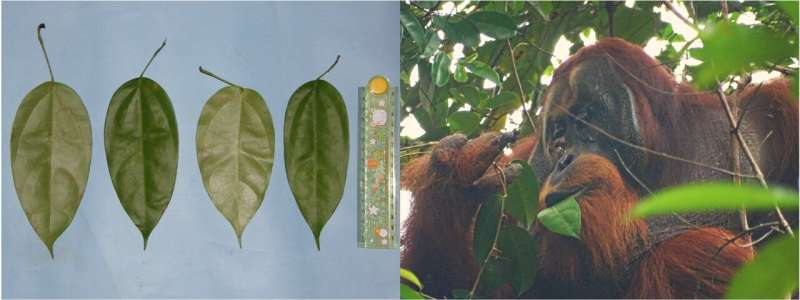Orangutan seen treating wound with traditional medicine in first for wild animals
Indonesian scientists document extraordinary case of Rakus the Sumatran orangutan, who covers his facial wound with mesh made from chewed leaves
Your support helps us to tell the story
From reproductive rights to climate change to Big Tech, The Independent is on the ground when the story is developing. Whether it's investigating the financials of Elon Musk's pro-Trump PAC or producing our latest documentary, 'The A Word', which shines a light on the American women fighting for reproductive rights, we know how important it is to parse out the facts from the messaging.
At such a critical moment in US history, we need reporters on the ground. Your donation allows us to keep sending journalists to speak to both sides of the story.
The Independent is trusted by Americans across the entire political spectrum. And unlike many other quality news outlets, we choose not to lock Americans out of our reporting and analysis with paywalls. We believe quality journalism should be available to everyone, paid for by those who can afford it.
Your support makes all the difference.An orangutan has been seen treating a wound using a plant with known pain-relieving properties, marking the first known instance of a wild animal deliberately tending to its injuries with medicine.
Researchers in Indonesia documented a male Sumatran orangutan with a facial wound repeatedly applying sap from a plant with anti-inflammatory and pain-relieving properties that’s long been used in traditional medicine.
The ape also covered its wound with a mesh made from the plant’s leaves, suggesting that treatment of wounds with medicine may have arisen in a common ancestor shared by humans and apes.
Self-medication by ingesting plant parts is widely seen across animal species, but treatment of wounds with a specific biologically active substance has not been documented previously.
In the course of routine observations in Indonesia’s Suaq Balimbing area, researchers noticed that a male orangutan named Rakus had sustained a facial wound, most likely during a fight with a neighbouring male.
A few days later, they saw the injured orangutan ripping off leaves from the plant Akar Kuning (Fibraurea tinctoria), chewing on them and repeatedly applying the resulting sap precisely onto his wound for several minutes.
Finally, he fully covered the wound with the chewed leaves.
Akar Kuning is known for its pain-relieving properties and is widely used in traditional medicine to treat diseases like malaria.
“Analyses of plant chemical compounds show the presence of furanoditerpenoids and protoberberine alkaloids, which are known to have antibacterial, anti-inflammatory, anti-fungal, antioxidant, and other biological activities of relevance to wound healing,” the researchers noted.

The orangutan’s wound didn’t show any sign of becoming infected and after five days it was already closed.
“The behaviour of Rakus appeared to be intentional as he selectively treated his facial wound on his right flange, and no other body part, with the plant juice,” Isabelle Laumer, one of the study’s authors, said. “The behaviour was repeated several times.”
The researchers suspect wound treatment by the orangutan using a medicinal plant may have emerged through individual innovation.
“Orangutans at the site rarely eat the plant. However, individuals may accidentally touch their wounds while feeding on this plant and thus unintentionally apply the plant’s juice to their wounds,” said Caroline Schuppli, another author of the study.
“As Fibraurea tinctoria has potent analgesic effects, individuals may feel an immediate pain release, causing them to repeat the behaviour several times,” Dr Schuppli added.
The behaviour is the first-ever report of active wound management with a biologically active substance in a great ape species, shedding light on the existence of self-medication in the closest relatives of humans.
In the case of humans, wound treatment is first mentioned in a medical manuscript dating back to 2200BC, describing the cleaning, plastering and bandaging of wounds with special substances.
“As forms of active wound treatment can also be found in both African and Asian great apes, it is possible that there exists a common underlying mechanism for the recognition and application of substances with medical or functional properties to wounds and that our last common ancestor already showed similar forms of ointment behaviour,” scientists said.
Subscribe to Independent Premium to bookmark this article
Want to bookmark your favourite articles and stories to read or reference later? Start your Independent Premium subscription today.

Join our commenting forum
Join thought-provoking conversations, follow other Independent readers and see their replies
Comments